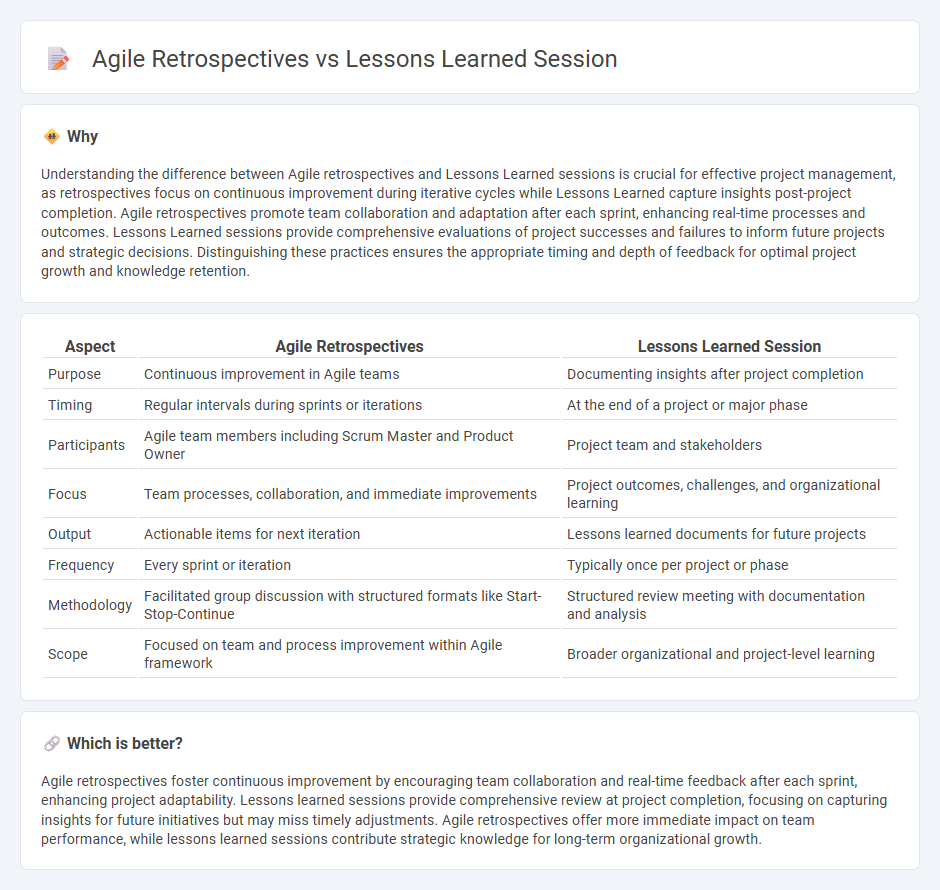
Agile retrospectives focus on continuous team improvement by regularly reflecting on recent sprints to identify actionable changes, fostering adaptability and immediate problem-solving. Lessons learned sessions aggregate insights from entire projects or phases, providing comprehensive knowledge to inform future initiatives and reduce repeated mistakes. Explore how integrating both can enhance project management effectiveness.
Why it is important
Understanding the difference between Agile retrospectives and Lessons Learned sessions is crucial for effective project management, as retrospectives focus on continuous improvement during iterative cycles while Lessons Learned capture insights post-project completion. Agile retrospectives promote team collaboration and adaptation after each sprint, enhancing real-time processes and outcomes. Lessons Learned sessions provide comprehensive evaluations of project successes and failures to inform future projects and strategic decisions. Distinguishing these practices ensures the appropriate timing and depth of feedback for optimal project growth and knowledge retention.
Comparison Table
| Aspect | Agile Retrospectives | Lessons Learned Session |
|---|---|---|
| Purpose | Continuous improvement in Agile teams | Documenting insights after project completion |
| Timing | Regular intervals during sprints or iterations | At the end of a project or major phase |
| Participants | Agile team members including Scrum Master and Product Owner | Project team and stakeholders |
| Focus | Team processes, collaboration, and immediate improvements | Project outcomes, challenges, and organizational learning |
| Output | Actionable items for next iteration | Lessons learned documents for future projects |
| Frequency | Every sprint or iteration | Typically once per project or phase |
| Methodology | Facilitated group discussion with structured formats like Start-Stop-Continue | Structured review meeting with documentation and analysis |
| Scope | Focused on team and process improvement within Agile framework | Broader organizational and project-level learning |
Which is better?
Agile retrospectives foster continuous improvement by encouraging team collaboration and real-time feedback after each sprint, enhancing project adaptability. Lessons learned sessions provide comprehensive review at project completion, focusing on capturing insights for future initiatives but may miss timely adjustments. Agile retrospectives offer more immediate impact on team performance, while lessons learned sessions contribute strategic knowledge for long-term organizational growth.
Connection
Agile retrospectives and Lessons Learned sessions both focus on continuous improvement by reflecting on past experiences to identify successes and areas for growth. Agile retrospectives occur regularly within iterative cycles, fostering immediate process adjustments, while Lessons Learned sessions typically provide comprehensive project insights at milestones or project completion. Together, they enhance organizational knowledge by promoting transparent communication, accountability, and adaptive strategies in project management.
Key Terms
Continuous Improvement
Lessons learned sessions capture insights from completed projects to improve future endeavors by documenting successes and failures. Agile retrospectives encourage iterative team reflection after each sprint, fostering continuous improvement through collaborative feedback and adaptive planning. Explore how integrating both approaches can enhance your organization's continuous improvement culture.
Feedback Loop
Lessons learned sessions typically occur at the end of a project and focus on documenting outcomes, challenges, and best practices for future reference. Agile retrospectives happen iteratively at the end of each sprint, emphasizing continuous improvement through immediate feedback loops and team collaboration. Explore how integrating these practices can enhance your project management efficiency and team performance.
Action Items
Lessons learned sessions typically summarize project outcomes and highlight key insights without immediate follow-up, whereas Agile retrospectives emphasize continuous improvement by identifying actionable items for subsequent sprints. Agile teams prioritize clear, specific action items that directly influence team behavior and project processes, fostering iterative growth and adaptability. Explore effective strategies to transform action items into measurable results in your project workflows.
Source and External Links
Lessons Learned Next Level Communicating - This article discusses the importance of identifying lessons learned in project management, focusing on project success and failure to improve future performance.
Guide to Lessons Learned in Project Management - This guide outlines the steps to hosting a lessons learned meeting, including recapping positive outcomes, introducing icebreakers, and generating actionable items.
How to Run a 'Lessons Learned' Session - This article provides a 5-step process to running a lessons learned session, emphasizing planning, gathering input, and analyzing feedback.
 dowidth.com
dowidth.com